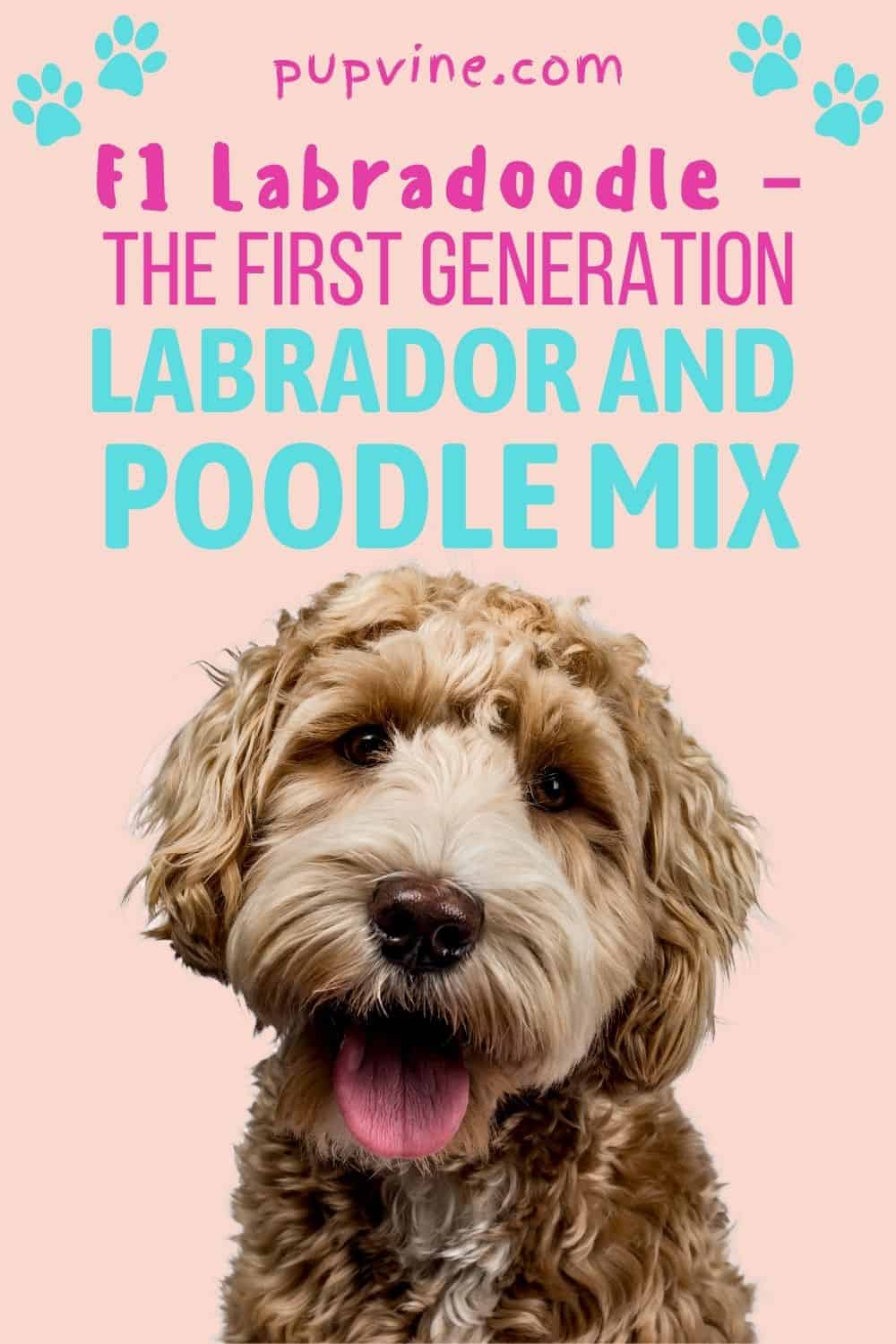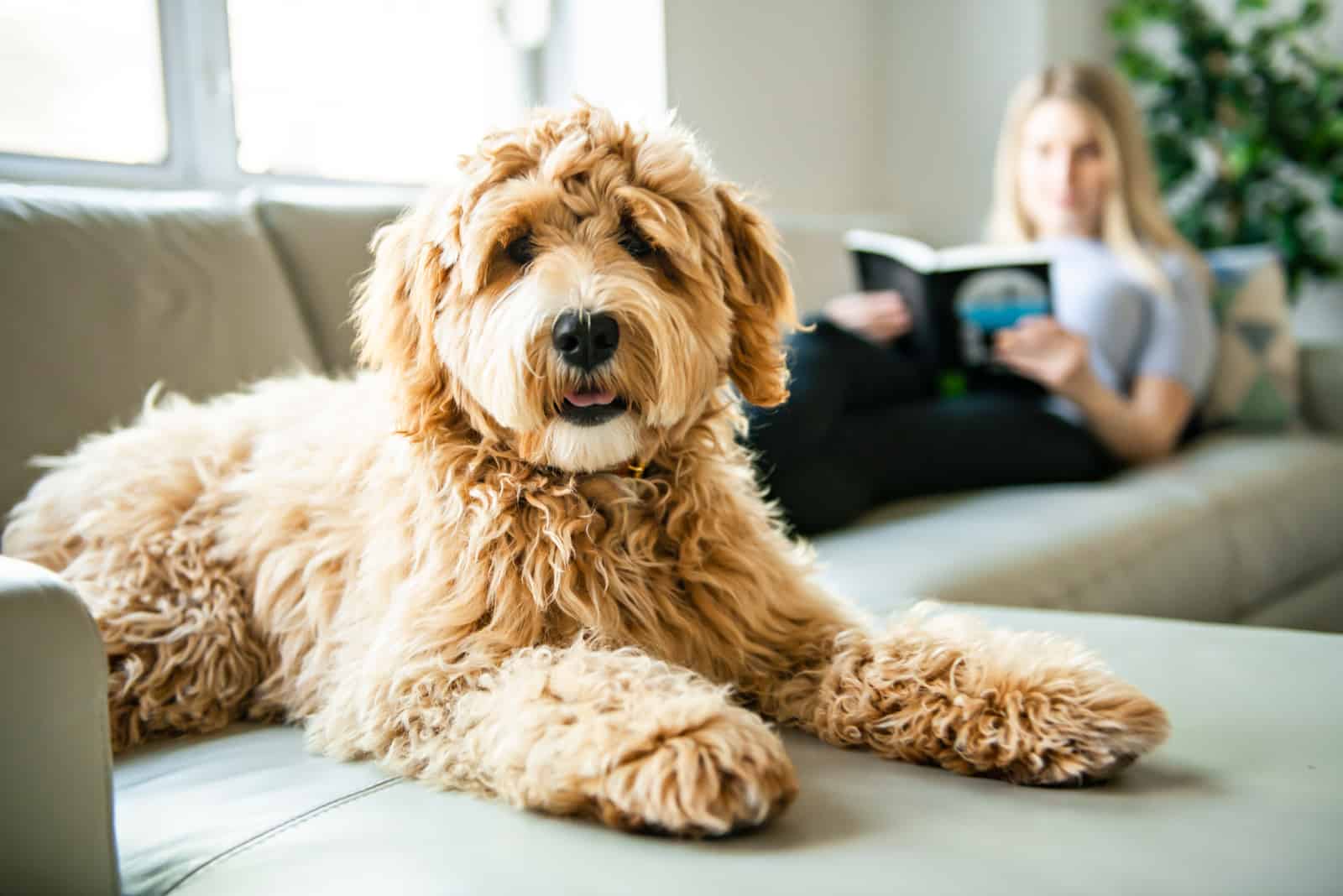Do you love Labradoodles? If you’re here, chances are you do. In fact, you might even be looking to get a Labradoodle for yourself! But do you know what F1 Labradoodles are, and how are they different from other F Labradoodles you might see being advertised for sale?
Labradoodles are a crossbreed of a purebred Labrador Retriever and a purebred Poodle. They are what is known as designer dogs, cute little mixed breed dogs with features everyone will love.
These adorable dogs look like living teddy bears and behave like you’re their everything. They are affectionate and adorable, so it’s no surprise that they quickly become some of the most popular hybrid dogs you can get.
If you’re looking to become a Labradoodle owner yourself, you’ve probably noticed those weird letters and numbers before the Labradoodle you’re looking at.
F1 Labradoodles, F2BB Labradoodles… What does this even mean?
These numbers and letters indicate a Labradoodle generation, something that I’ll get in-depth in this article. Also, I’ll focus on the original, first-generation Labradoodle.
If this sounds interesting, buckle up. Here’s everything you need to know about F1 Labradoodles and what makes them so special:
What Is an F1 Labradoodle?
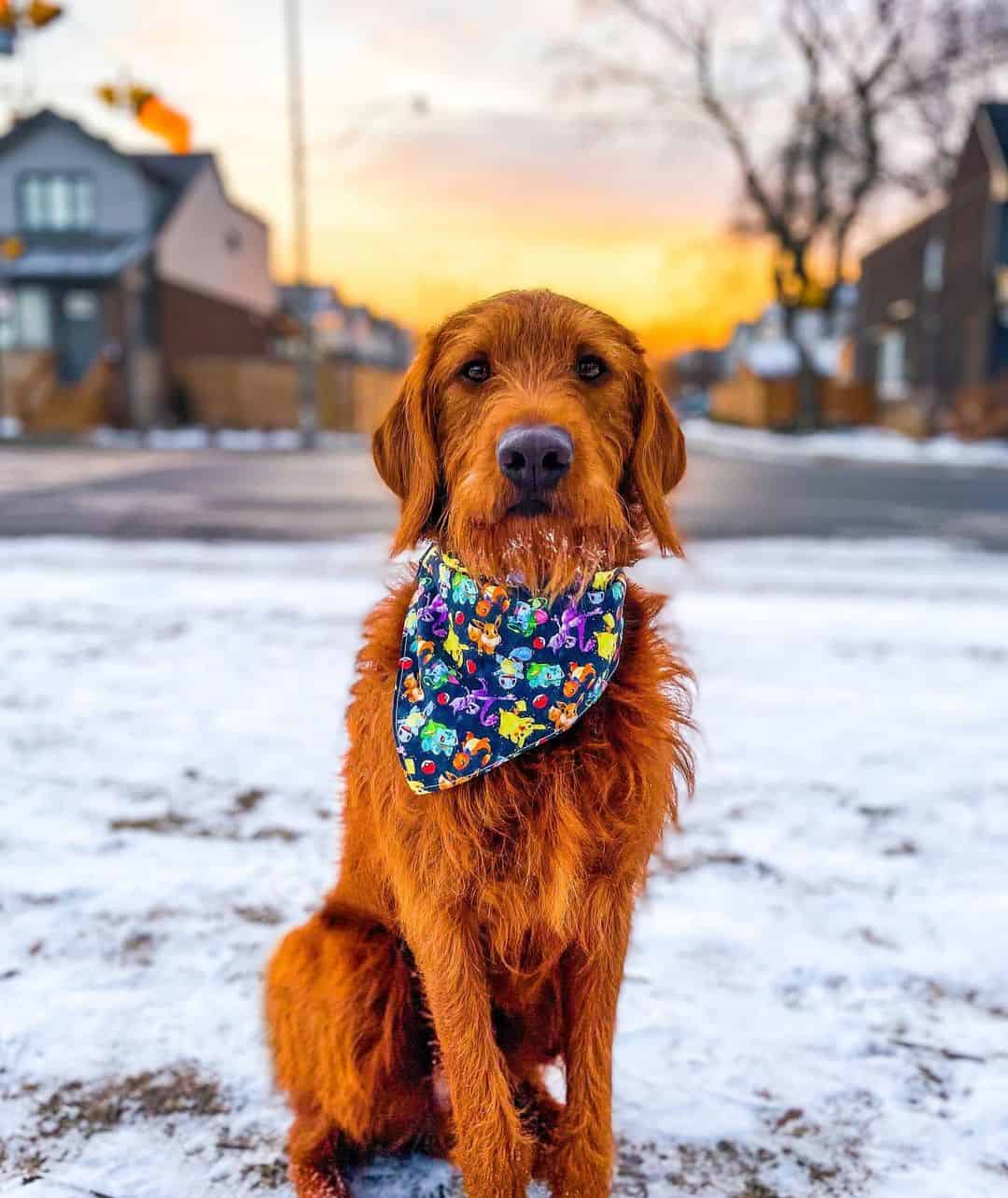
Photo from: @dobbyisafreedoodle
F1 Labradoodle is the puppy born when you breed a purebred Poodle and a purebred Labrador Retriever. This is a first-generation crossbreed – a dog born from two purebred dogs that belong to different dog breeds.
When most people think of Labradoodles, they imagine F1 dogs – a direct descendant of Poodle and a Labrador dog.
However, they aren’t the only generation of Labradoodles. There are several other types of Labradoodles, and while all are similar, they also have significant differences between them.
Before I can get into that, it’s important to understand crossbreeds a bit better.
Crossbreed Controversy
Mixed breed dogs have been controversial since the first day they appeared.
Some dog experts and breeders think of crossbreeds as mutts. They think they are impure and are ruining the purebred dog’s bloodline.
There is some sense behind such thoughts. Breed standards exist for a reason, and mixing bloodlines of different dog breeds does change how a dog might behave and appear.
Also, many reputable breeders of purebred dogs are not agreeing with the breeding practices of crossbreed breeders.
This is because mixed breed dogs aren’t accepted by the American Kennel Club (AKC) and other major kennel clubs. This means that regulating such breeds is a challenge, which leaves a lot more space for unhealthy practices.
Despite this, there are many benefits to cross breeds such as the Labradoodle.
First and foremost, these dogs are unique and don’t have the appearance of standard dog breeds you can see at dog shows. This makes them a great choice for dog owners who want to have a dog like no other.
Next, mixed breed dogs, such as the F1 Labradoodle, have all the best features of both their parents. This is a great way to add some traits to the dog you’d like – for example, to fix some temperamental flaw or to lower his shedding amount.
For example, all Poodle mixes – also known as Doodles – are there to help create allergy-friendly dogs that won’t cause too many problems for allergy sufferers. Labradoodles are among them.
Finally – and most importantly – crossbreeds tend to be healthier than purebred dogs. This is because of something called hybrid vigor.
Hybrid vigor occurs in puppies that have had a large gene pool. It greatly lowers the chances of health problems in dogs and ensures the puppies are as healthy as possible.
In fact, crossbreeding might be a way to remove certain genetic conditions from bloodlines. For example, Cavalier King Charles Spaniels are known for many health problems they have. By mixing them with other dog breeds, breeders can create healthy offspring.
Labradoodles, however, were mostly created to get friendly family pets that won’t cause issues to people with dog allergies.
Labradoodle Generations
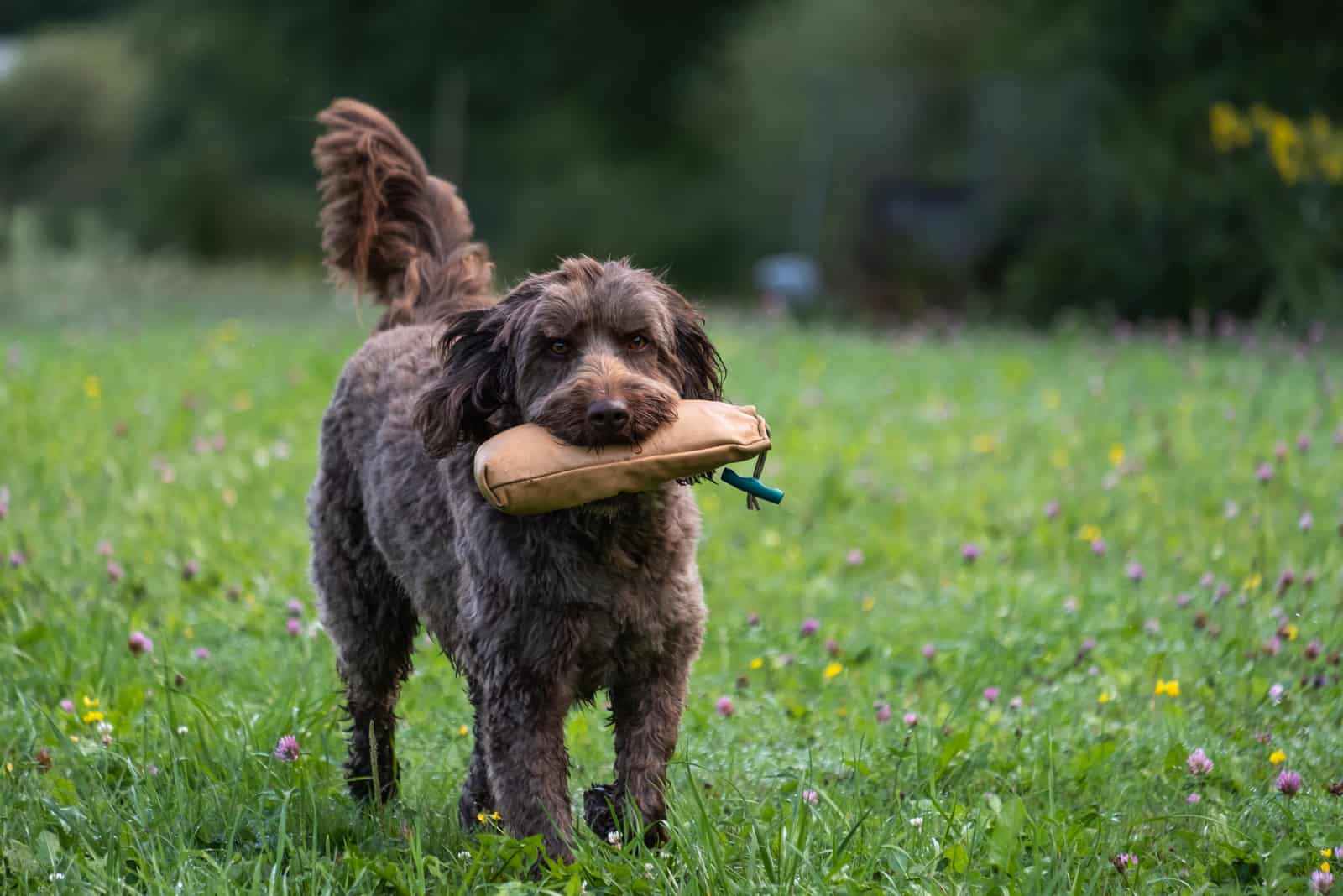
Now that we’ve fully explained crossbreeds, it’s time to talk about different Labradoodle generations.
The term generation is used to describe how many generations ago a crossbreed was made. For example, when you first breed a Poodle and a Labrador, you get the first generation.
Then, when you breed two first-generation Labradoodles, you get the second generation, and so on.
It’s important to know how these generations go and what the differences are, especially if you’re getting Labradoodles because you want a hypoallergenic dog. Otherwise, you might end up with a dog that doesn’t have all the traits you wanted.
As for the letters and numbers you see, they are simply a way to mark these generations. Here’s what everything means:
• F is to indicate that a dog is a mixed breed.
• Numbers indicate what generation is in question.
• B means that the dog is a backcross.
Now, I’ll explain some of the most common generations, before we go back to detailing the F1 Labradoodle dogs.
F1 Labradoodle
F1 Labradoodle is a Labradoodle that is 50% purebred Poodle and 50% purebred Labrador Retriever. As mentioned before, this generation is created by combining two purebred dogs.
The biggest issue with the F1 Labradoodle is that the general appearance and behavior of the litter are hard to predict. There are many combinations of genes that might occur, and you can never know for sure what the adult dog is going to look like.
Still, these pups have a really strong hybrid vigor and they are the healthiest of all generations.
Most breeders will sell F1 Labradoodles, as these pups are very sought-after and many consider them to be the true Labradoodles.
F1B Labradoodle
F1B Labradoodles are the first-generation backcross. In other words, they are the result of breeding an F1 Labradoodle with a purebred dog that belongs to the parent breed.
Backcrosses are made when the breeder decides he wants to ‘return’ some genes of one of the purebred parents into the bloodline. Most of the time, they’ll use Poodles for this as they have more desirable properties.
Of course, it is possible to add the Labrador Retriever bloodline to the mix, but there really aren’t too many reasons why someone would do this.
For this reason, whenever I mention a backcross in the future, I will be referring to the backcross with Poodle.
As such, the F1B Labradoodle backcross is 75% Poodle and 25% Labrador Retriever.
This is probably the most common Labradoodle generation you can find at reputable breeders. It is more hypoallergenic than the F1 Labradoodle, and yet it doesn’t have so many Poodle genes to lose the significant Doodle look.
F2 Labradoodle
F2 Labradoodle is the second generation of Labradoodles. They are the result of breeding two F1 Labradoodle dogs. As such, they too are 50% purebred Poodle and 50% purebred Labrador Retriever.
While you might think these pups will inherit the overall appearance of their Labradoodle parents, the truth is quite opposite. This is the least stable Labradoodle generation out of all.
The reason behind this is the large number of recessive genes that might not have been present in the parents but will express themselves in the F2 puppy litters.
This is why many responsible breeders avoid breeding F2 Labradoodles. There is no real way of knowing what a puppy will look like, even if parents look almost exactly the same.
Also, F2 Labradoodles don’t have as strong hybrid vigor as F1 Labradoodles, but they are still rather healthy.
F2B Labradoodle
Similar to F1B Labradoodles, this is a backcross. However, it occurs when you combine the F2 Labradoodle with a purebred Poodle.
There is another way to get an F2B Labradoodle, and that is by breeding an F1 Labradoodle with F1B Labradoodle – although this method isn’t commonly used as the puppy’s appearance and temperament isn’t as easy to predict.
These dogs are very similar in behavior and appearance to F1B Labradoodles since they are 75% Poodles and 25% Labrador Retrievers, as well.
They are usually created to fix the flaws of an F2 Labradoodle. By adding more Poodle genes, the breeder ensures the dogs are more hypoallergenic and less prone to shedding.
However, this generation doesn’t have nearly as strong hybrid vigor as F1 Labradoodles, even though all Labradoodles are healthier than their purebred parents.
F3 Labradoodle
F3 Labradoodles are the first of many multi generation Labradoodles – also known as multi-gen. They are the third generation of Labradoodles – but multi-gen Labradoodles can be F4 Labradoodles, F2BB Labradoodles, and many others.
F3 Labradoodles are also 50% Poodles and 50% Labradoodles. By now, they should have a somewhat determined appearance, and the look of their offspring should be easier to predict.
These dogs have the weakest hybrid vigor out of them all, and whether they’ll be hypoallergenic or not will depend on their parents and the genes they carry.
F1 Labradoodle Puppies
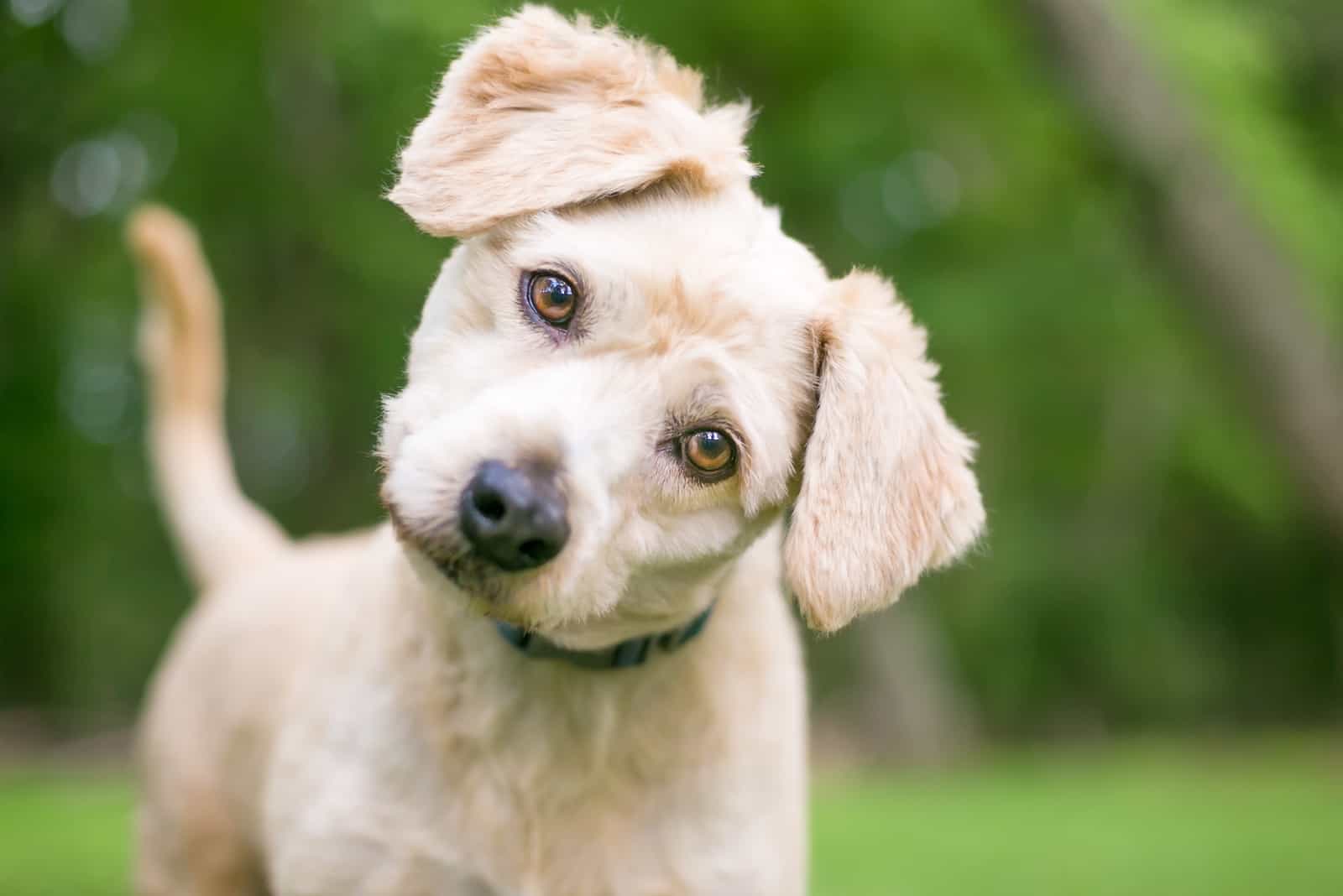
To get F1 Labradoodle puppies, a breeder needs to breed a purebred Labrador with a purebred Poodle. If the Poodle is of standard size, it doesn’t matter which dog is male or female.
However, if they’re breeding with a mini Poodle or a toy Poodle, the mother dog should be a Labrador Retriever.
While they are still very young puppies, these doggies will look like all other Doodles. Only when they start to grow older will you be able to see their individual features, such as the coat type and the true coat color.
If choosing your new F1 Labradoodle puppy and you need your dog to be non-shedding, try consulting with a breeder. Still, keep in mind that it is nearly impossible to exactly predict what a Labradoodle puppy will look like once they are adult dogs.
Full Grown F1 Labradoodle
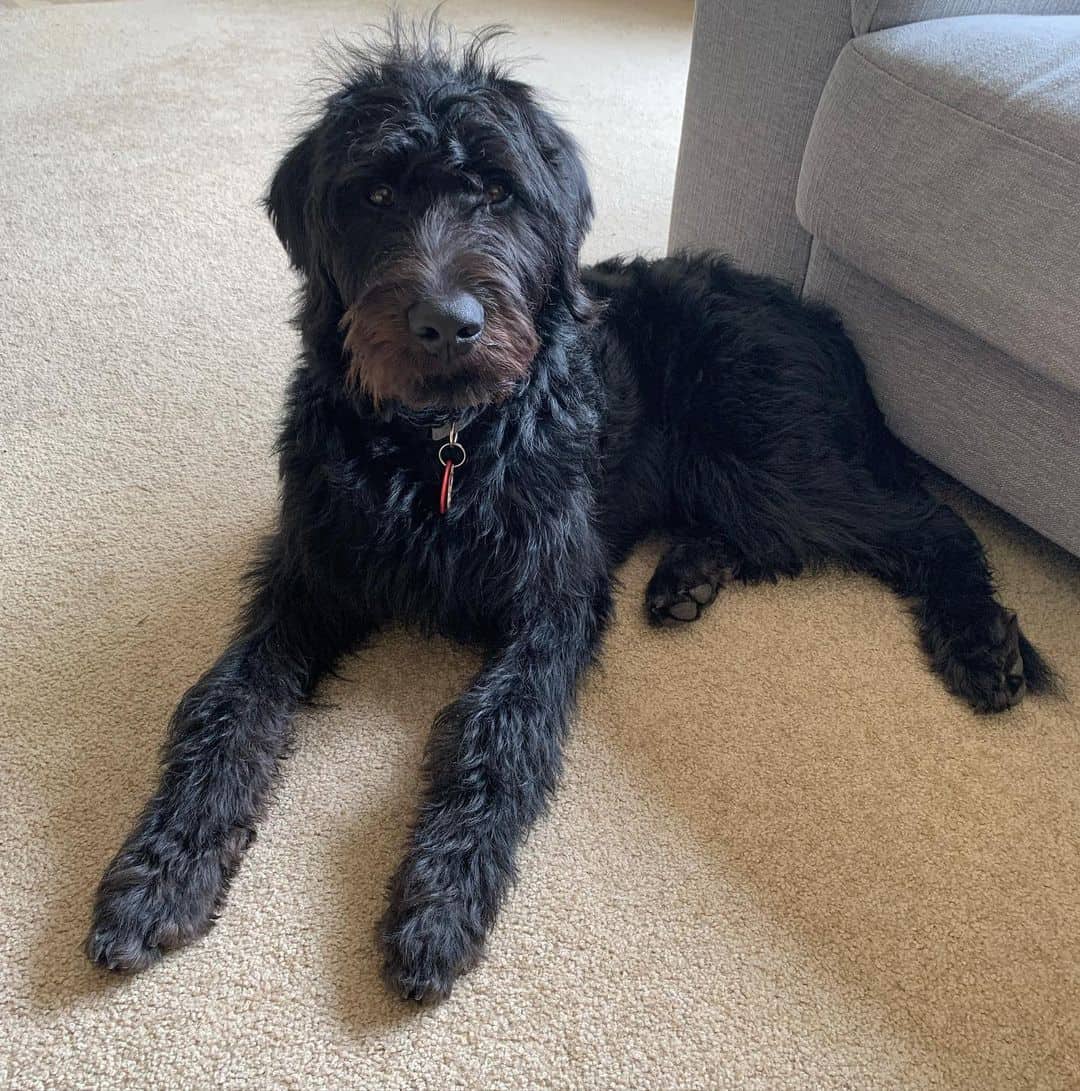
Photo from: @cooper.la.pooper
F1 Labradoodles are bred to be the perfect combination of good temperament, health, and adorable appearance. Still, no one can precisely know what a full-grown F1 Labradoodle will look like – other than predicting the coat color.
A desirable Labradoodle will have an elegant and compact body, strong legs, and a rounded face with floppy ears. It will have round, dark eyes, and a muzzle shaped upwards, giving it the appearance of a smiley face.
The coat type and color of these dogs can vary, but the most desirable F1 Labradoodles will have a curly coat that is non-shedding. Such a coat makes these dogs suitable for people struggling with dog allergies.
Just like Goldendoodles, Labradoodles can have their coat styled in many different haircuts, giving each dog a very unique appearance that might even change the dog’s entire look!
To ensure your pooch has all the best features, you should always purchase from reputable breeders only, as they’ll know how to combine purebred dogs to get the best Labradoodle possible.
F1 Labradoodle Size
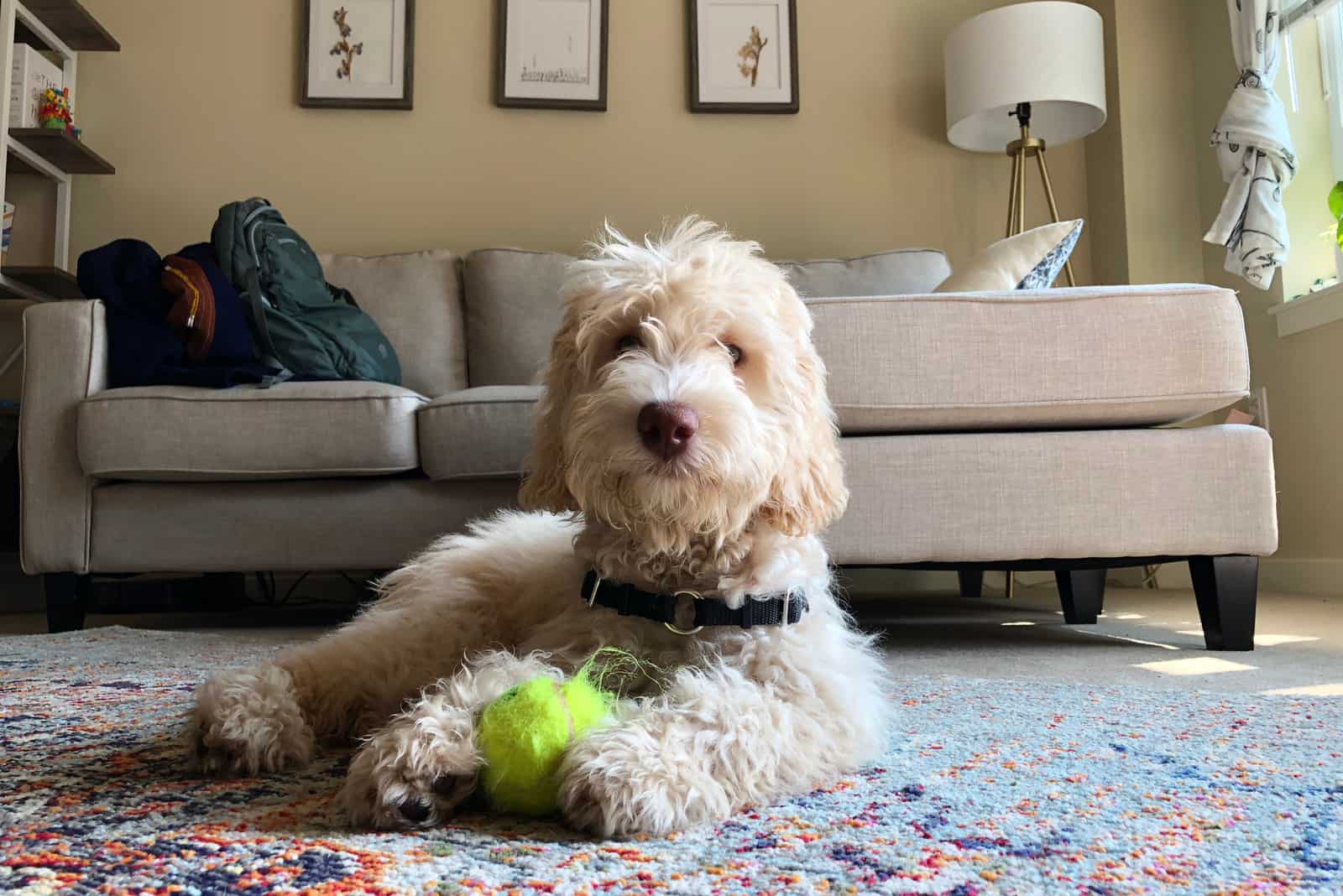
F1 Labradoodles can come in many sizes. Labrador Retrievers are medium-sized dogs, and there isn’t too much variation with this. This is why the size of an F1 Labradoodle is usually determined by the size of its Poodle parent.
Poodles can come in three sizes:
• Standard poodle.
• Miniature Poodle.
• Toy Poodle.
Some kennel clubs also recognize the Moyen Poodle, but as this size isn’t registered by the AKC, I won’t talk about it too much.
It’s important to note that it can be nearly impossible to predict the size of an F1 Labradoodle, unless both dogs are of similar height.
This is because a mixed breed puppy can be anywhere between the sizes of his parents.
In other words, if you breed a Labrador Retriever with a toy Poodle, you can get either a mini, medium, or standard Labradoodle.
However, the median sizes usually have the highest outcome.
This is why the final size of a Labradoodle is usually determined in backcrossed generations by adding more Poodle genes.
Standard F1 Labradoodle
Standard F1 Labradoodles are the easiest ones to get. All a breeder needs to do is to combine a Labrador Retriever with a Standard Poodle.
Most Standard Labradoodles will have a height of 21 – 24 inches. Their weight will depend on the dog’s build, but this should usually range between 50 and 65 pounds.
This is very similar to the size of a purebred Labrador Retriever, as these dogs will usually have a height of 21.5 to 24.5 inches.
Medium F1 Labradoodle
Medium Labradoodles can be achieved in many ways. In fact, this is the most common F1 Labradoodle size. You can get them by breeding a Labrador with a mini or a toy Poodle.
Medium F1 Labradoodles usually have a height of 17 – 20 inches, and a weight of 30 to 45 pounds – although, once again, their weight will highly depend on their build.
This type of Labradoodle is significantly smaller than the Labrador Retriever, but it is usually larger than its Poodle parent.
Mini F1 Labradoodle
Mini F1 Labradoodles are the rarest of them all. They are extremely challenging to produce, even when you choose the tiniest toy Poodles you can find.
Most Mini Labradoodles come from backcross generations. For example, you can breed a smaller medium Labradoodle with a toy poodle to get an even smaller Labradoodle that will be considered mini.
Mini Labradoodles have an average height of 14 to 16 inches, with a weight of 15 to 25 pounds. Most F1 Labradoodles will be larger than that.
F1 Labradoodle Coat Type
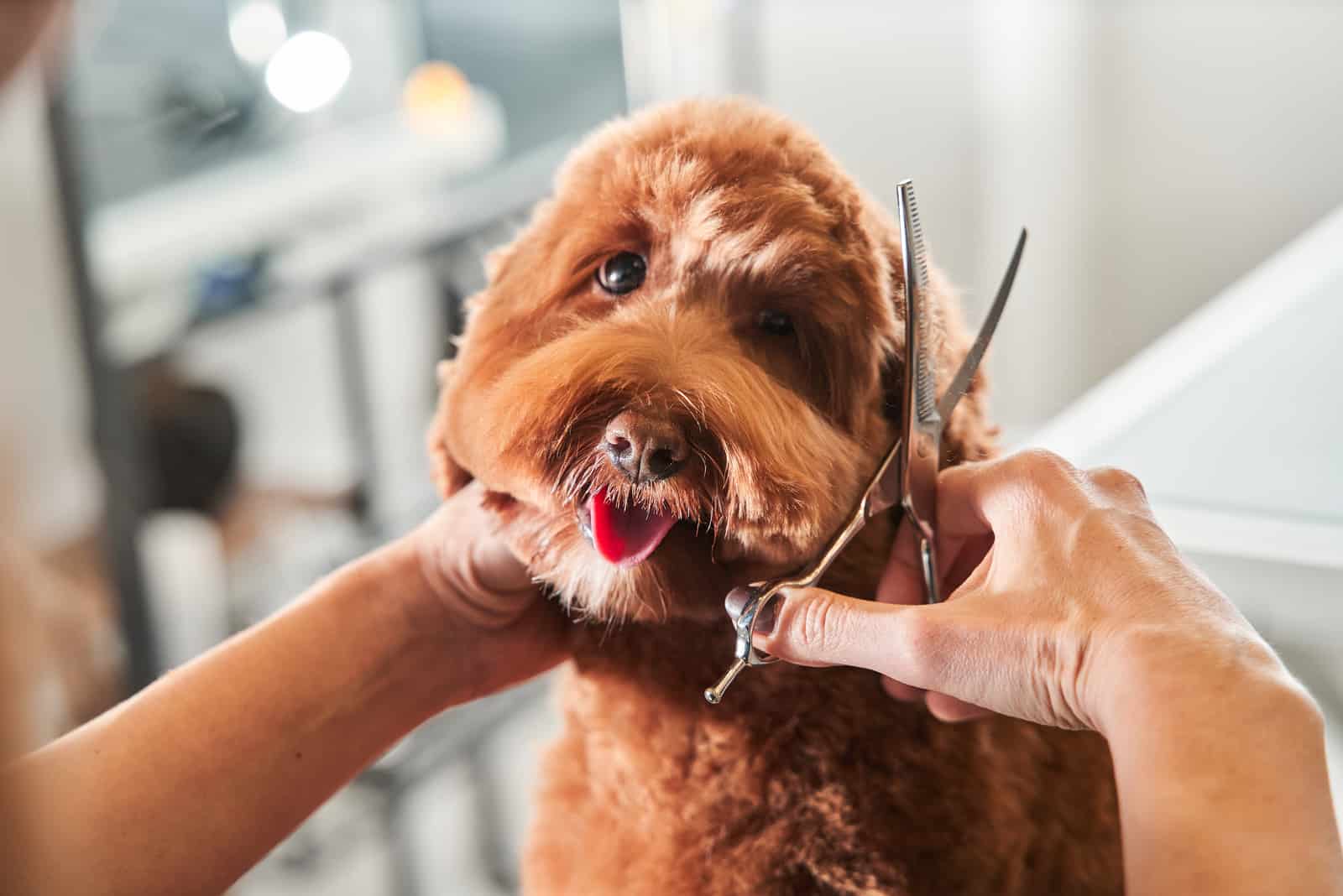
Labradoodle coats can come in three types:
• Curly coat.
• Wavy coat.
• Straight coat.
They can also come in three different textures:
• Wool coat.
• Fleece.
• Hair.
In general, curly coats are the most desired of them all, especially if they have a wool or fleece texture. This is because it’s non-shedding and hypoallergenic.
With F1 Labradoodles, knowing what type of coat a dog will have is nearly impossible. Still, after looking at hundreds of Labradoodles, it seems like the straight coat is the least common one.
Labradoodles inherit straight coats from their Labrador Retriever parents. This type of coat isn’t very popular, as it is highly-shedding.
A straight coat usually comes with the hair texture, which only increases the amount of shedding, something no Labradoodle owner wants.
Wavy coats seem to be the most common ones. They are something between straight and curly coats. As such, they are mild to non-shedding and fairly easy to groom as they aren’t as prone to matting and tangles as wavy coats.
Curly coats are inherited from the Poodle parent. This is the type of coat most dog owners want, as it’s non-shedding and great for people with dog allergies.
However, a curly coat also requires lots of maintenance. It is very prone to mats, especially if it comes in the form of wool or fleece.
F1 Labradoodle Coat Colors
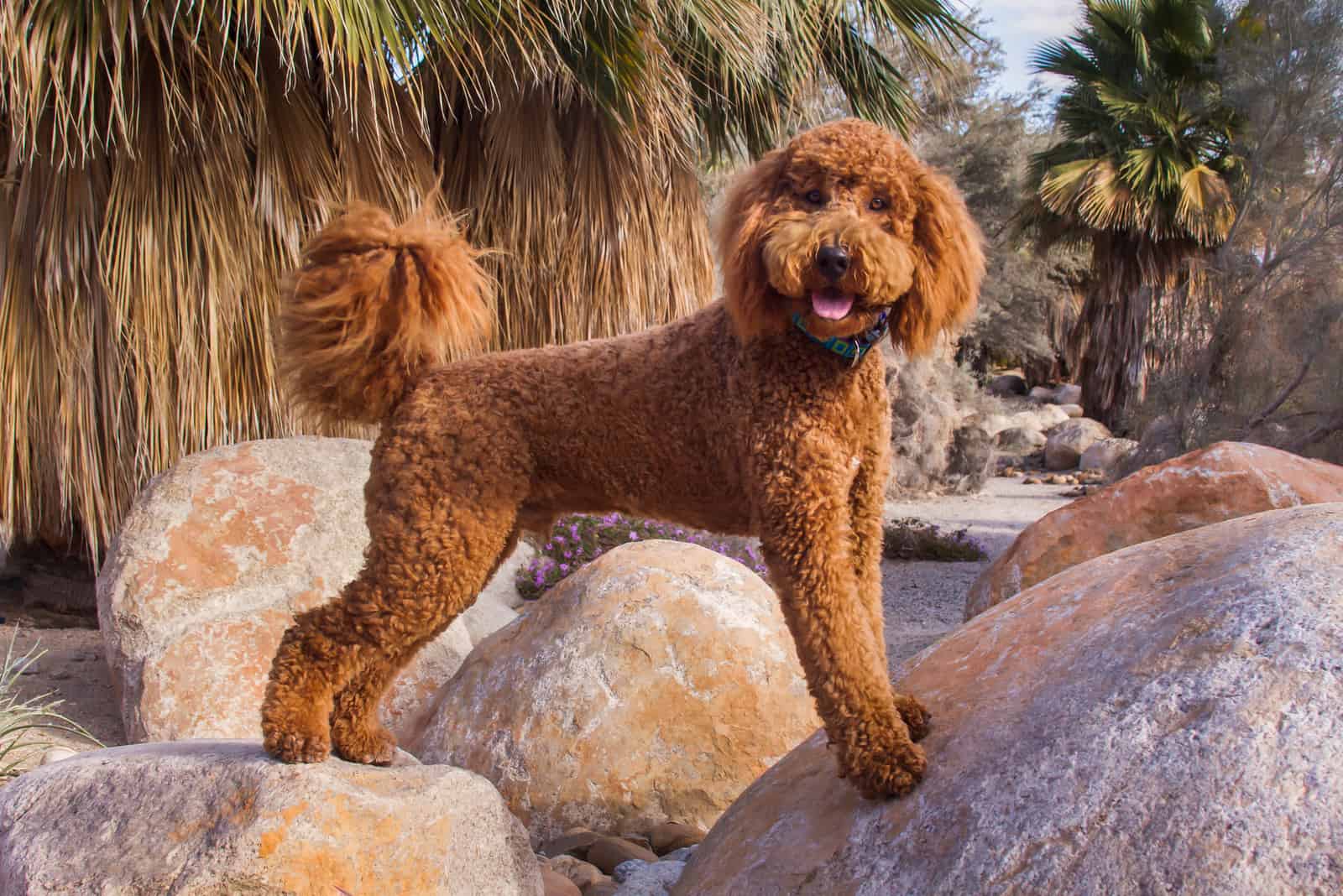
While Goldendoodles are still considered the best Doodles by many, Labradoodles hold a tight second spot and some might even argue that F1 Labradoodles are better than F1 Goldendoodles.
The main reason for this is that Labradoodles can come in dozens of various coat colors and patterns.
Labrador Retrievers are recognized in three coat colors:
• Yellow.
• Black.
• Chocolate.
On the other hand, Poodles can come in almost any coat color imaginable. This allows for some very colorful color combinations in the offspring – even though the most common ones will be the Labrador coat colors, as they can be found in both parents.
Some of the most wanted Labradoodle colors include:
• Cream Labradoodles – the most common F1 Labradoodle color. They come in a very light gold shade that is almost white.
• Gold Labradoodles, which are also known as caramel Labradoodles or apricot Labradoodles. They come in various yellow shades that are lighter than the red coat.
• Black Labradoodles – they are somewhat common, but the biggest issue is that, for the Labradoodle to be considered truly black, it shouldn’t have any white markings.
• Chocolate Labradoodles are the result of a dilution gene affecting the black coat color. As a result, not only is this dog rich brown in color, but its nose should be brown instead of black, as well.
• Red Labradoodles. This might be the rarest F1 Labradoodle color out of them all, as red isn’t the common color in either of the parent breeds. They come in a deep red coat color, but with black noses and dark eyes.
• Blue Labradoodles are also known as brown Labradoodles. This is because the blue color isn’t recognized by the color of the dog’s coat, but rather his nose. As such, blue Labradoodles have a diluted brown to blue coat with a blue nose and lighter eyes. There cannot be any black colors present on them.
• Chalk white Labradoodles. They are lighter than the cream Labradoodles, but their color is not truly white, especially if you were to place them next to some pure white dogs.
• Parchment Labradoodles have a color of white coffee. Sable markings are common, so the dog might appear to come in two shades.
• Phantom Labradoodles – a name to describe a specific coat pattern. These pups have a base color and specific markings in other colors. These markings are usually located across the dog’s chest, above its eyes, on its muzzle and chins, and they can affect the paws, as well. The coat colors don’t matter, as long as the markings follow this pattern.
• Parti Labradoodles. This isn’t exactly a coat color, but rather a type of markings. These doggies usually have a white base coat with large patches of color. The most common color combination is black and white, although other colors are possible, as well.
• Abstract Labradoodles – Finally, this is an irregular pattern that doesn’t fall into any of the above mentioned categories. The only important feature is that their coat shouldn’t be more than 50% white, as this would then make them parti Labradoodles.
In general, F1 Labradoodles might have fewer varieties in coat color than other generations. This is because they have a greater chance of inheriting their Labrador Retriever parent’s coat color, and the options there are somewhat limited.
Still, they are much more colorful than the first generations of most other Doodles.
Things To Be Aware Of
It’s important to note that some coat colors have been connected with certain health problems Labradoodles might struggle with.
For example, chocolate F1 Labradoodles are more prone to any health condition, and they appear to have a shorter lifespan.
Similarly, blue and chocolate F1 Labradoodles might get a color dilution alopecia, but this condition seems to be more common in standard and medium Labradoodles than in smaller sized dogs.
The chances of getting a healthy dog increase when you buy from a reputable breeder, as these people won’t sell dogs that are shown to have any genetic health problems.
Not just that, but choosing an F1 Labradoodle based on the coat color alone isn’t the best idea.
F1 Labradoodles are known to change colors as they go from puppyhood to adulthood. Usually, a puppy will be in a darker shade than they’ll be once they grow up.
Similarly, some black and blue Labradoodles might experience graying. This is the process during which their coat colors get a gray or silver shade.
While I don’t think this color change has any effect on the dog’s cuteness – quite the opposite, I think it adds a unique factor to the pup’s appearance – many dog owners end up disappointed. As such, this is something you need to be aware of.
F1 Labradoodle Shedding
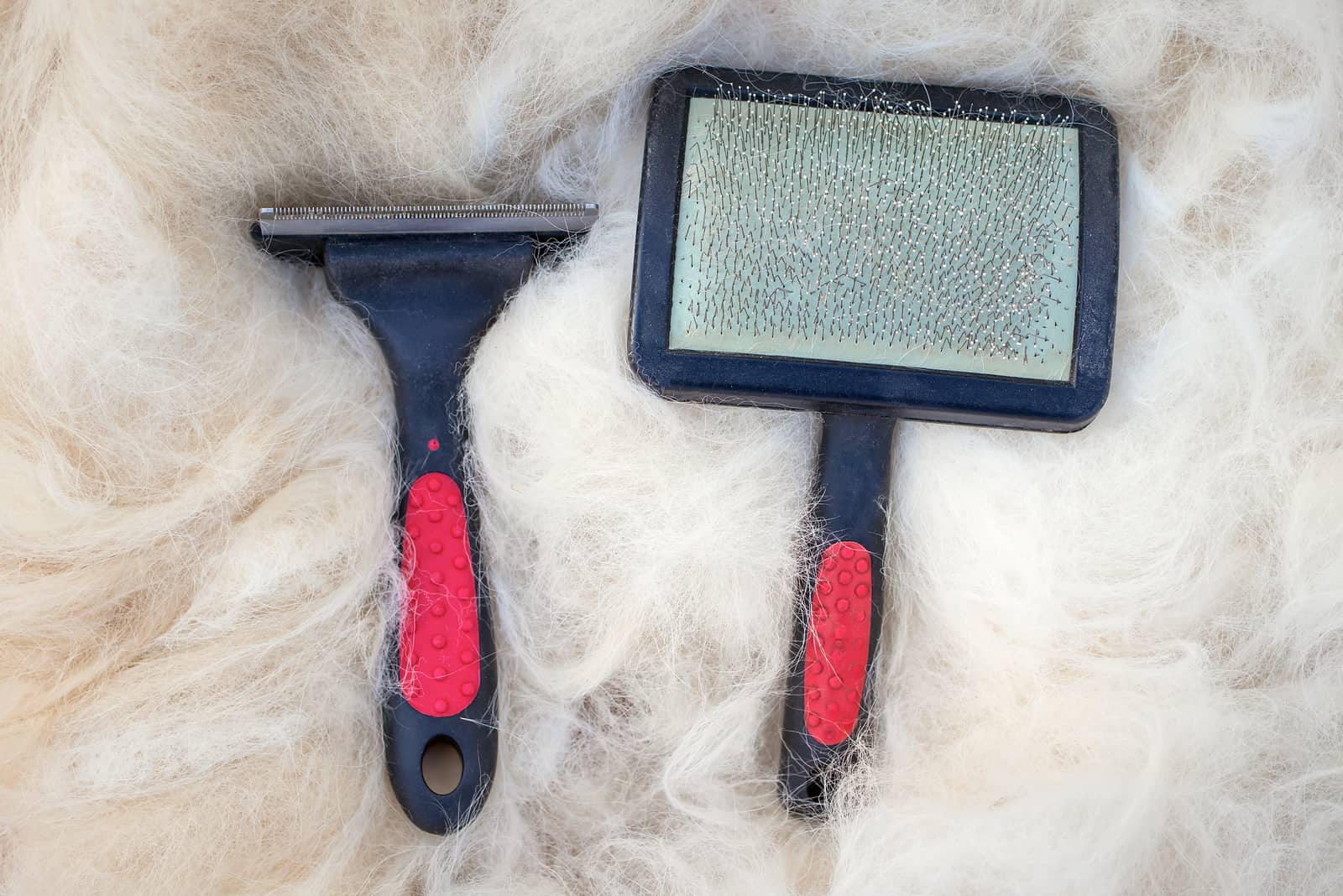
Labradoodle shedding is yet another aspect of F1 Labradoodles that will entirely depend on from dog to dog.
If your pooch inherited lots of Labrador genes, he is likely to experience moderate to severe amounts of shedding.
On the other hand, dogs that have inherited the coat type of Poodles will be non-shedding.
F1 Labradoodles with a wavy coat that is somewhere in between are usually going to be shedding, but only a tiny amount.
The good thing is that F1 Labradoodle shedding is usually easy to keep under control. Only the heaviest of shedders are going to cause you trouble.
In case your Labradoodle is highly shedding, here are some options to keep this shedding amount under control:
• Brush your pooch daily.
• Don’t bathe your F1 Labradoodle too often! Once every few months will be enough. Otherwise, you are risking making their skin worse.
• Vacuum daily to make sure your house and furniture are clean.
• Use upholstery covers. They are easy to clean – all you need to do is remove them and put them in a washing machine.
• Feed your F1 Labradoodle with high-quality dog food.
• Use omega acids supplements such as fish oil. They will ensure your puppy’s coat is shiny and healthy.
• Don’t miss vet check-ups. Excessive shedding and hair loss can be a sign of many health conditions.
Are F1 Labradoodles Hypoallergenic?
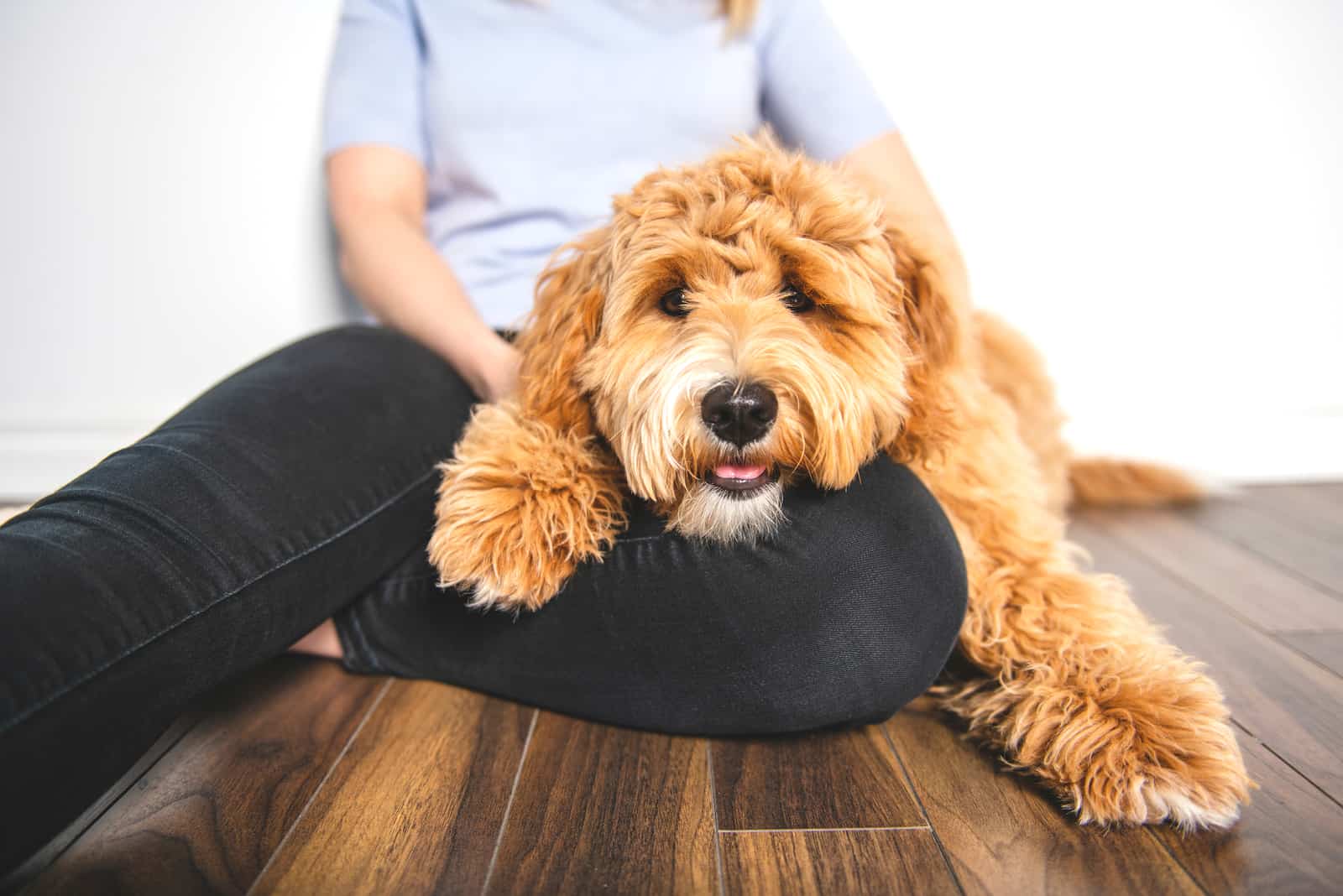
One of the main reasons why Labradoodles are so desired is because they are considered hypoallergenic. Still, there are a few things I want to make clear.
First off, whether or not an F1 Labradoodle will be hypoallergenic depends on its coat type. As I’ve already said, Labradoodle’s coat can come in several shapes and forms, and not all are the same.
For example, if your Labradoodle has a straight coat, he will likely shed a lot – although this amount should never be as high as in Labrador Retrievers.
On the other hand, if he has a curly coat, then loose hairs won’t fly everywhere, spreading allergens. Instead, they’ll stay tangled in the curls and wait until you groom your pooch with the best Labradoodle and Goldendoodle brush. There are many great products on Amazon and similar websites.
However, there is another thing that you might not know, and that is that there isn’t a truly hypoallergenic dog.
While you might think or feel like it’s dog’s hair that’s causing you health issues, it isn’t that. Instead, you’re having an issue with a protein found in the dog’s saliva, urine, and dander. This is something all dogs secrete.
When it comes to dander (dead skin flakes), it will get stuck onto the dog’s hair, and then it’ll spread everywhere with the individual strands.
This is why you might be sneezing or experiencing breathing problems after playing with your dog. It isn’t his hair that’s causing you problems, but rather dander.
As you cannot find a dog that doesn’t secrete dander, urine, and saliva, you can conclude that there isn’t a dog that doesn’t produce allergens.
However, when a dog isn’t shedding too much, the dander doesn’t have a way to travel through the air. Also, not all dogs will drool in the same amount, and some dog breeds are very tidy about where they go potty.
Labradoodles are considered clean dogs that will hate to get dirty. They don’t drool, and some of them are non-shedding.
Because of this, some F1 Labradoodles can be considered hypoallergenic. This will mostly depend on their coat.
Another thing that’s important to know is that the more Poodle genes the puppy has, the more likely he is to inherit hypoallergenic properties Labradoodle breeders and owners are so proud about.
This is why most backcrosses are much more allergy-friendly compared to F1 Labradoodles.
F1 Labradoodles Temperament
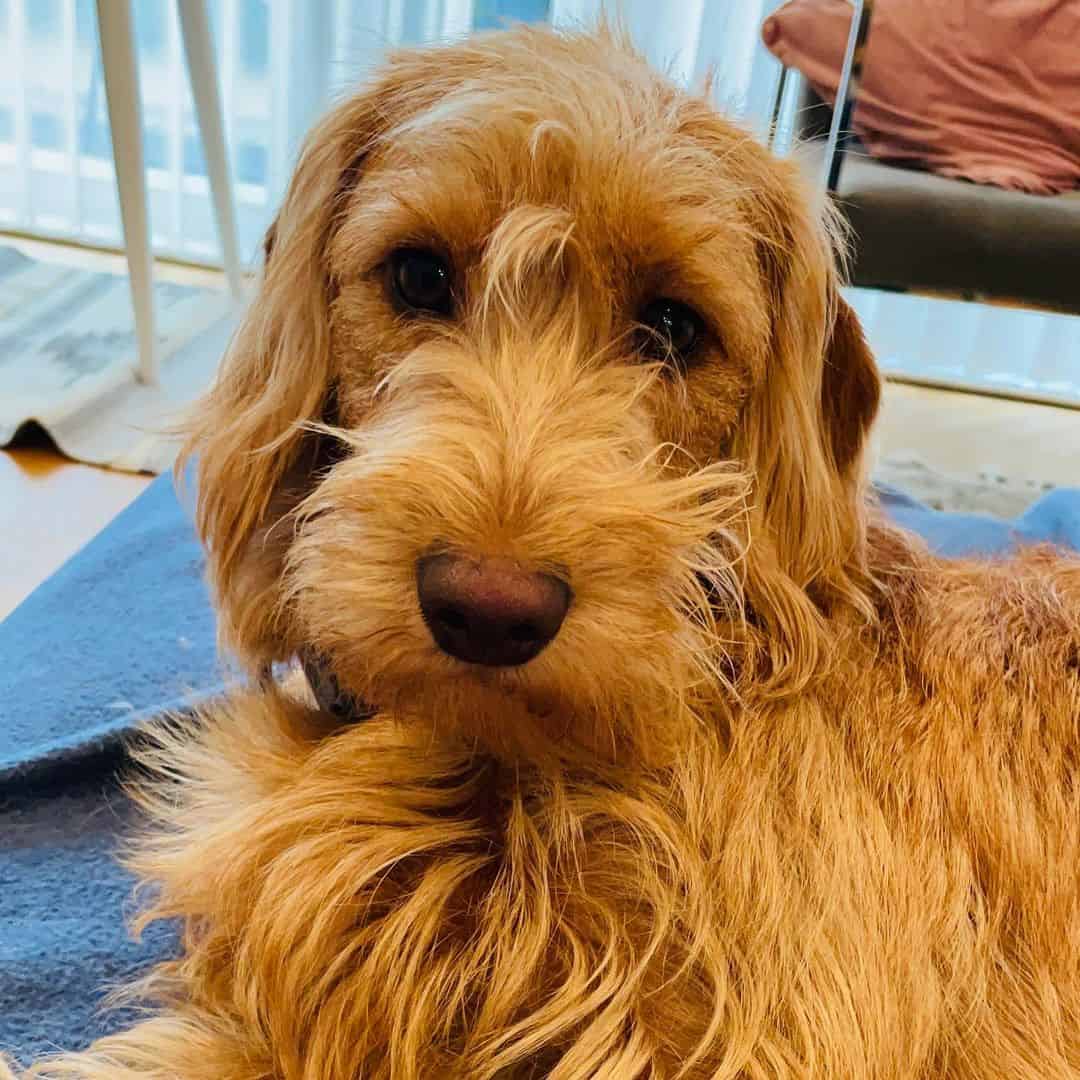
Photo from: @momochan_the_labradoodle
F1 Labradoodles have some of the best personalities you can find in Doodles! They are a perfect combination of a cheerful Labrador Retriever and a friendly Poodle, which can result in an amazing low-shedding family pet.
These dogs are very adaptable, so they can get used to the change in the environment rather quickly. They’ll rarely have an issue adapting to a new home or to a new family member.
In fact, they might be the best dogs out there if you’re planning on expanding your family. They are amazing with kids, as they see children as their playmates. Also, they can be protective of the little ones and they’ll do their best to ensure nothing happens to them.
At the same time, F1 Labradoodles have a very low prey drive. They’ll love all other dogs and small animals, and they’ll rarely show a hunting instinct.
However, they can be energetic and playful to the extreme, so you should still monitor them while around very small kids, especially if they are in standard size.
A large F1 Labradoodle might accidentally knock a child over during playtime, causing injuries. This isn’t done out of malice – these pups simply want to play all day long!
These are affectionate dogs that love to please their owners. They will want nothing more than to make you happy.
When you combine their eagerness to please with their high intelligence, you’ll get a dog that is very easy to train. Potty training and obedience training is a piece of cake when you have such a loyal and smart companion.
All of this is a reason why they are some of the best service dogs you can find. No dog breed can make better therapy dogs or guide dogs than an F1 Labradoodle.
Sure, other Labradoodle generations can also do a great job in helping people. However, certain generations, such as the F2 Labradoodles, can be too unstable, while the backcrosses have too many Poodle genes, which will lower the chances of a Labradoodle puppy inheriting the Labrador’s cheerful nature.
F1 Labradoodles are a perfect mix of both parent breeds, making them some of the best family pets and companions out there.
F1 Labradoodle Health Problems
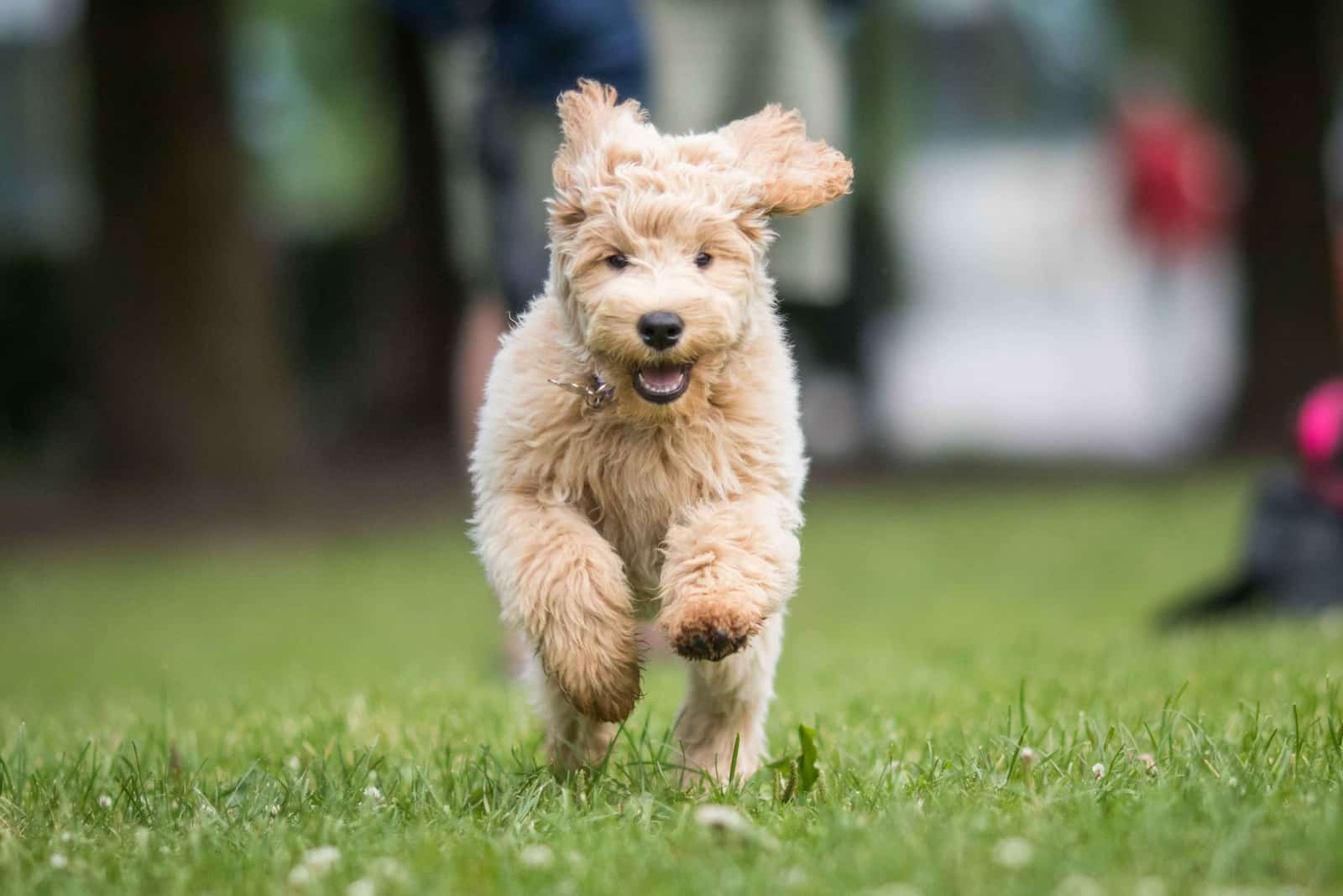
As mentioned briefly before, F1 Labradoodles are the healthiest of all Labradoodle generations. They have plenty of genetic variation that ensures they have lots of healthy genes to pick from.
Of course, this doesn’t mean they are entirely free of all health problems. Theoretically, they can get any health problem their parents can get, which means they are prone to more health conditions than their parents, but their chances of actually getting it are rather slim.
From their Labrador Retriever side, these dogs can struggle with:
• Hip dysplasia.
• Osteochondritis Dissecans.
• Eye problems.
• Epilepsy.
• Gastric torsion (bloat).
• Epilepsy.
Then, from their Poodle side, they are prone to:
• Addison’s Disease.
• Von Willebrand’s disease.
• Hypothyroidism.
Also, some Labradoodles might struggle with allergies. They can develop an allergic reaction to some types of dog food, tobacco smoke, or even to certain products such as dog shampoos.
Still, F1 Labradoodles are rather healthy dogs that won’t experience many health problems throughout their lifetime. The only important thing is to buy them from a reputable breeder who chooses AKC-registered dogs that have undergone numerous health tests.
As F1 Labradoodles are the healthiest Labradoodles, you can expect them to live a long and happy life. Their average lifespan is 12 to 15 years, but with proper care, they might live even a few years longer.
The most important thing is to make sure you feed them the right type of dog food and to give them enough exercise so they don’t become obese.
Obesity is the main reason why many Labradoodles end up sick or unhealthy, as it can lead to an increased chance of many health problems – most notably, orthopedic and cardiac problems.
F1 Labradoodle Breeders
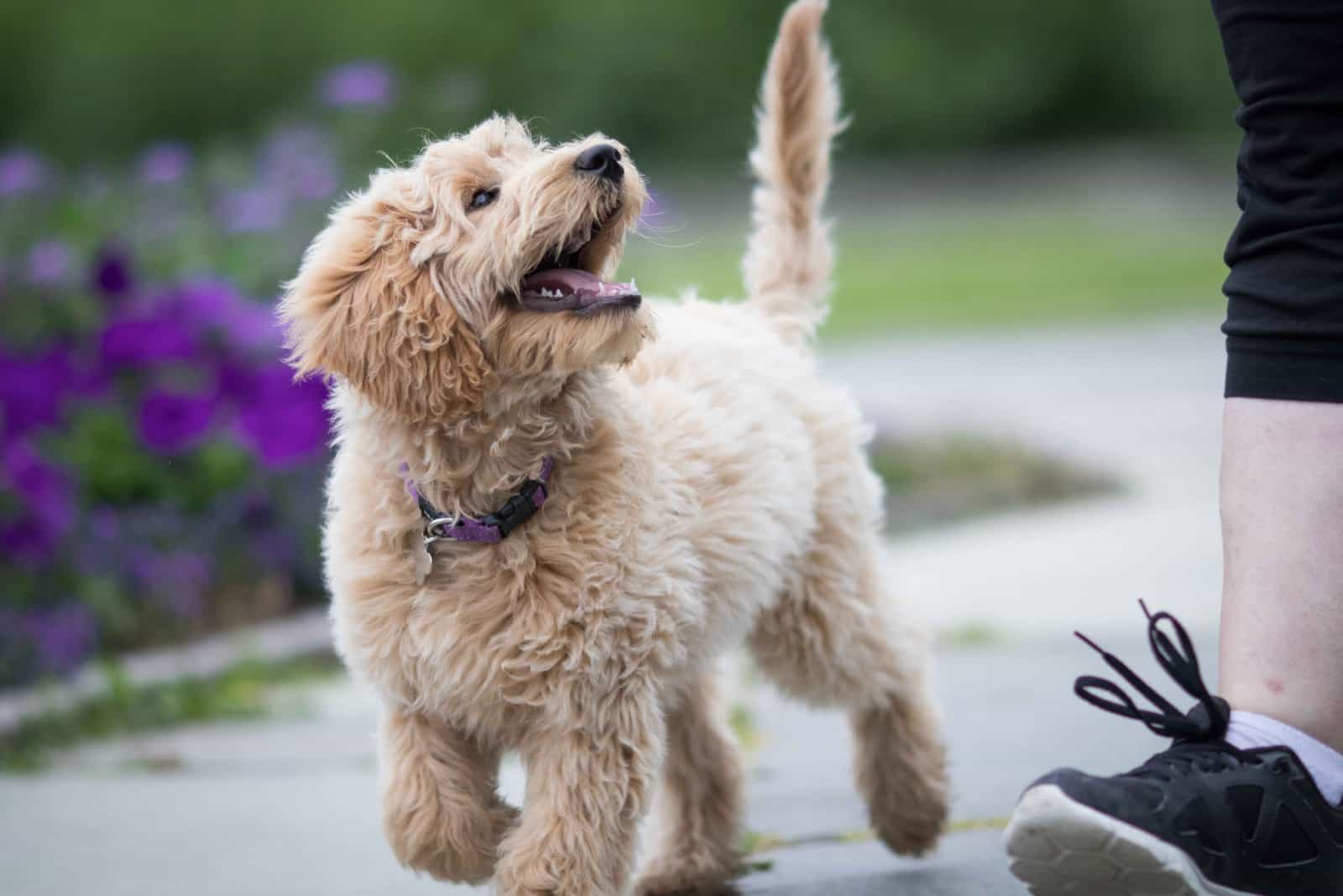
Many reputable breeders will breed F1 Labradoodles, especially if they also sell purebred Labrador Retrievers and Poodles or one of the parent breeds.
In fact, most F1 Labradoodle breeders will also breed F1B Labradoodles, as they’ll already have the parent dogs on their property.
When looking for the best F1 Labradoodle breeder, you need to find reputable people who are familiar with breeding crossbreeds.
These people know how to choose the parent dogs and to create top-quality litter. Their puppies will have the best of both worlds, and many will have a non-shedding coat – even though this is something even the best breeder out there cannot influence.
Also, whether you are looking for an F1 Labradoodle, Goldendoodle, or Australian Labradoodle, you want to look for a breeder that conducted health tests on their dogs.
While F1 Labradoodles are generally healthy, the risk of inheriting some genetic condition is always there. To make it as low as possible, you need to buy from a breeder that paid to have their dogs checked.
No good breeder will be happy about selling you a dog that might have some health issues. Quite the opposite – they’ll go out of their way to ensure all of their litters are healthy.
This is the best way to differentiate a reputable breeder from a backyard breeder or a puppy mill.
The latter two locations won’t care about the health of their puppies, or they won’t even know this is necessary. Their biggest goal is to sell their dogs without any care of what will happen afterward.
F1 Labradoodle Price
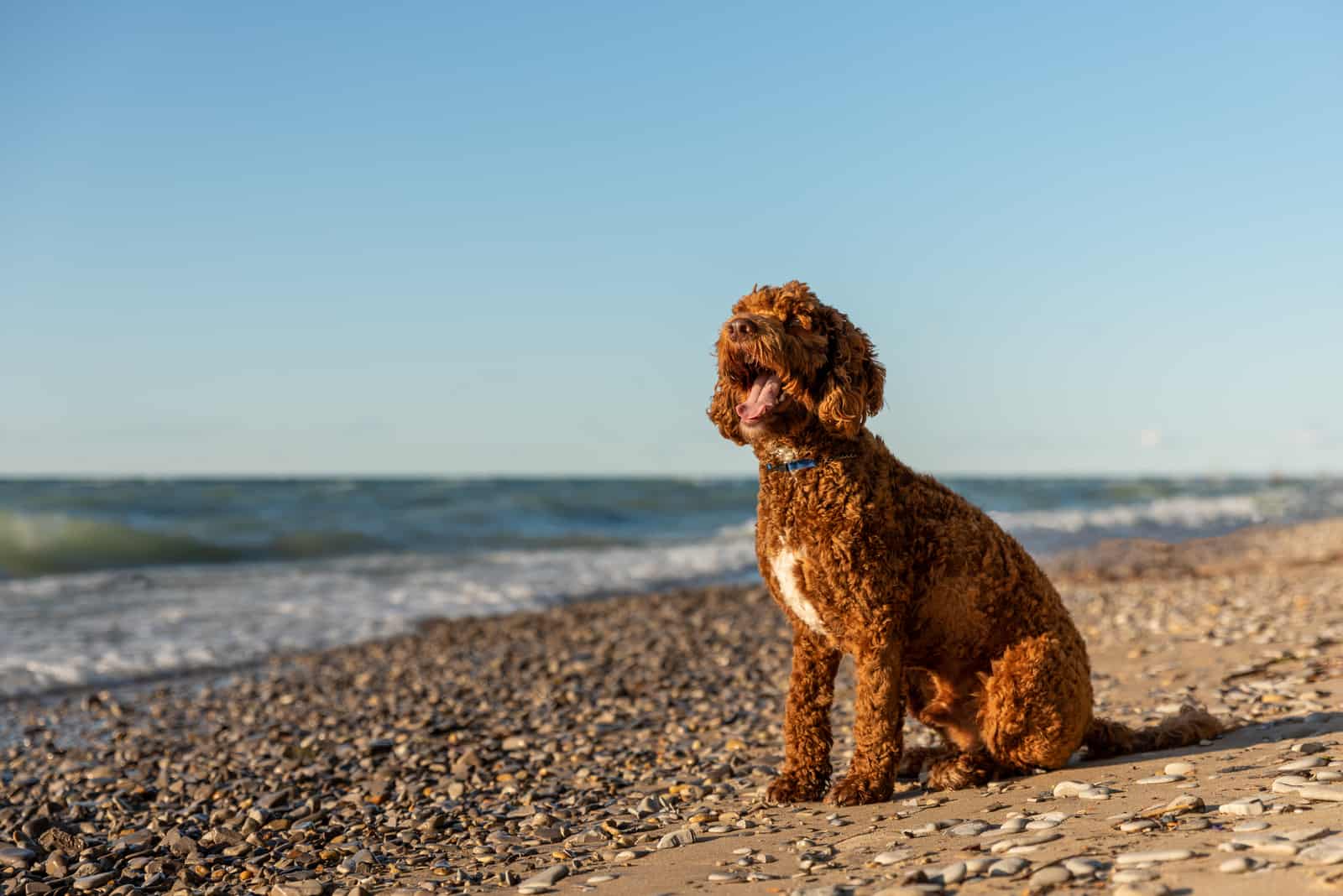
F1 Labradoodles can vary in price greatly depending on their parent’s bloodline, the location where you’re purchasing them from, and their coat type.
Low-shedding and non-shedding dogs are considered desirable, so these pups will have a higher price – especially if they come from parents with good bloodlines that have been registered by the AKC.
Labradoodles that shed will usually have a significantly lower price, as most people looking for Labradoodles want hypoallergenic dogs.
You might also adopt a Labradoodle from a shelter, which will result in even lower prices. Most rescue organizations will let you have a dog at an adoption fee that might be as low as $150.
In general, though, F1 Labradoodles can cost anywhere between $500 and $4,000. This price can be significantly higher than the price of their purebred parents.
Is F1 Dog Better Than F2?
There has been some discussion about whether F1 Labradoodles are better than F2 Labradoodles. I have to say that I agree with people who think that F1 Labradoodles are one of the two best generations – the second one being the F1B Labradoodle.
F2 and multi-gen Labradoodles are fairly unstable. There are many genes that might appear even though they seemingly weren’t present in parent dogs.
Also, they don’t have as much hybrid vigor, as there isn’t that much genetic variation as in F1 Labradoodles.
F1 Labradoodles are often non-shedding, with the best behavior Labradoodles can possibly have. They are cute, adorable pups that have everything a person might look for in a Labradoodle.
While they are a bit unpredictable, a good breeder might increase the chance of F1 Labradoodle having desirable traits by choosing the right Poodle and Labrador. This isn’t something that is possible with F2 Labradoodles, and their features are entirely the product of luck.
Not just that, but they are among the easiest Labradoodle generations to breed, which is another reason why they are so popular.
Many breeders who breed F1 Labradoodles can also breed two other dog breeds, which will increase their experience and profit.
Either way, you won’t make a mistake no matter what Labradoodle generation you choose – unless you’re choosing a dog that won’t trigger your allergies, in which case you need to consult with the breeder about the right dog for you.
All Labradoodles make outstanding pets and their loyalty and cheerfulness is something you’ll forever remember and nurture. They truly are the reason behind the saying that a dog is a man’s best friend.
Read Next: 8 Reputable Mini Labradoodle Breeders In The United States
